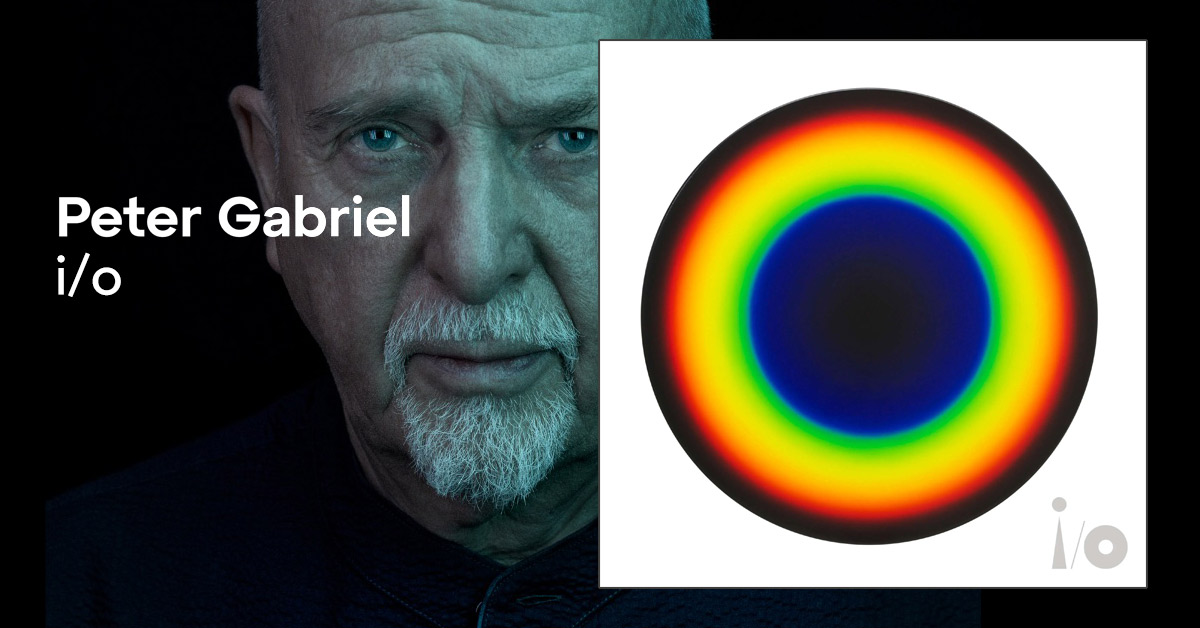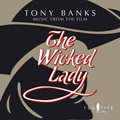


The song of i/o for April is called i/o - it's the title track of the album. These two letters are familiar from electrical devices and mean input/output or "the communication of one information system with another". So it means "to have contact - exchange". (But it is also often used as "on/off").
Gabriel made this conceptualisation think about "the stuff we put in and pull out of ourselfs, in physical and non-physical ways". We are all created from atoms and biochemistry. In order for us to grow, material is put into us - and comes out again. And when we eventually pass away, the atoms stay there and become something else (like an oak tree).
Maybe we "messed up individuals" learn something when we realise that we are part of a whole. That everything is connected. As a really deep realisation, this can give fulfilment. It also includes understanding for the earth and the environment.
So that's the thinking behind calling the album i/o. The idea is about 20 years old. But Gabriel soon wanted to write a song about it. And the song now expands on the theme in a disarmingly simple way.
Later in the year, in October, a music video for the song i/o appears, accompanying the announcement of the album's release date. Parts of it could already be seen on the tour. Further details about it can be found on our music clips page.
The song is also used in the teaser for the album and seems to be meant as something like its leitmotif.
The lyrics of the song outline the perception of the world and how we learn to think about it. It tells us that things are not always as we have been led to believe. The sweep verse highlights, "Stuff coming out, stuff going in, I'm just a part of everything". It goes on to talk about the ability to attach and connect, and to flow like water, without cause and effect: "i/o - I'm just a part of everything". The last verse speaks of the end of puffing and that one is laid to rest where life can "move freely in and out of me...".
The structure of the text as a whole is not particularly complicated, it is designed for rhythm and dynamics. There are winking moments and sometimes a few playful phrases, for example when "buzzards' wing" rhymes with "buzzing bees' sting".
There are four verses, separated by the chorus, which then continues into the choral "i/o - coming out, I'm going in". - Compact, but effective.
Only later in the year does it emerge that the line "we're just a part of everything" is integrated quite prominently into the album design and represents something like its slogan.
All lyrics of the album can be found on Peter Gabriel's website here.

The artwork this time is called Colour experiment no. 114, is from 2022 and by Olafur Eliasson, a Dane with Icelandic roots. It is a round painting, oil on canvas, diameter 80 cm.
It shows a dark circle in which a wide ring stands, reproducing the colours of the rainbows from the inside to the outside (although the violet, which is on the very inside, is barely discernible).
The series of paintings has existed since 2009 and the idea is to represent colour scales. Among other things, to mix and use a paintable colour for each value of the visible light waves.
Eliasson is primarily concerned with physical phenomena in nature such as light, reflection, visibility - but also water or movement. Gabriel finds Eliasson to be "a mixture of artist, scientist and - magician" whose works inspire us to think about how we interact with our environment.
We have gathered more about the artworks and artists behind them here.
Of the i/o songs so far, the title track is the shortest. Just under four minutes is radio-friendly - and the whole thing gives the impression of being simple and pleasing.
First there is simple piano accompaniment in very direct rendition (it sounds different from the almost concertante grandeur of the same instrument in Playing For Time). A short introduction, then Gabriel's singing begins. This too sounds rather close and untreated (although there is a slight reverb underneath).
To the first "stuff coming out", a discreet bass and light snare drum tones join in, along with a high-pitched plinking guitar.
From the second verse on, the drums really kick in (but remain dry and unagitated in the mix), resulting in a full band accompaniment that comes along gathered and measured.
Towards the "i/o" chorus, the pressure increases a little, but never becomes excessive, despite the hymn-like approach. This part is short and quickly over.
It is interesting that Gabriel has trouble with the last high note of "everything". He doesn't conceal it though - quite brave and naked.
A small detail can be heard in the brief pull back after the chorus: A scraping sound, like when driving over guitar sides. A small sign of the sound sculptor Rhodes...
New things only happen again in the interlude, when an unexcited but present solo comes from the D-whistle. Shortly before the end, another solo moment is placed in the "i/o" climax - this time from the guitar.
After two choruses, the song ends somewhat unexpectedly - when everything has been brought forward.
Gabriel could have made quite a bombast out of the piece - but he chose to keep it in a version with tension in the serenity.
Basically, the regular i/o band plays here. It's nice that David Rhodes on guitar finally comes briefly into his own a little. This restrained person in the restrained production of this piece, of all things.
And it's also nice that with Richard Evans on the D-whistle, an old acquaintance from Gabriel's band stock turns up again.
On the other hand the Soweto Gospel Choir, so emphasised in the press text for the song, hardly makes an appearance - only at the very end as reinforcement of the "i/o" passages. It is astonishing that here again (after the special mention of Melanie Gabriel on The Court) a spotlight is put on something that then hardly makes a difference in the arrangement.
Finally it's interesting to note that Katie May, actually the head engineer at Real World Studios, is represented here on even more instruments than on the previous i/o pieces. However, she continues to work more in the background.
In general, it is becoming more and more apparent that Tchad Blake's mixes serve more "rock" ideas, and Spike's those of "pop". Often only with subtle means.
This becomes clear again with i/o. In the Dark-Side Mix, the song sounds more like the recording of a band in the studio than like symphonic opulence. The arrangement has lost its fullness, but individual elements stand out more.
Basically, this version has less reverb, less space. The bass is warmer and more present, but above all the drums are much more in the foreground. Its sound is more detailed, but also less integrated into the overall arrangement. Lost from everything and so far forward, it seems a little clattery.
In contrast, many ornamental elements are reduced. The (sampled?) guitar plinking, for example, comes in much later (in the second verse). Others are omitted altogether. On the other hand, the underpinning synth sounds are still there after the intermediate part, and even seem to have increased, as they are now more clearly audible and distinguishable.
The "i/o" chorus no longer sets in so powerfully. Again, the focus sits on hearing a compact band play rather than creating volume. It seems less dense - and drier.
And then there is a small but interesting moment after the instrumental interlude and Evans' D-whistle solo: the accompaniment is briefly reduced almost completely to bass and drums, which sounds a bit like a concert when the clap-along part comes. It doesn't come here, of course, and the full band is right back again. But the Bright-Side Mix doesn't have this movement in the arrangement.
And the Soweto Gosple Choir - contrary to what some expected - has not become more present. And certainly not longer to hear. Apparently, the recording with him is actually just that short.
On the whole, at any rate, it can be said that the Dark-Side Mix has less of a grand gesture. To convey the intention of the song in this way is not easy.
The third of the main mixes is always a remarkable offering, if only because of its acoustic three-dimensionality. The one on i/o also has quite a few successful details.
The beginning is not particularly different from the other two versions. The sound is perhaps a little more reminiscent of the Dark-Side Mix than the Bright-Side Mix. And it is noticeable that the In-Side Mix is mixed quieter overall.
However, it becomes obvious that it is a Dolby Atmos mix from the first moment. When you move your head to the left or right using Apple Air-Pods Pro, you get the feeling that the piano in the middle sounds wider and still fills the space to the sides. Peter's vocals sound as if they come directly from the front and then stay in that position when you move your head.
The flageolet tunes of the guitar that start at "Stuff coming out, stuff going on" move discreetly and atmospherically from side to side at the end of the first verse. At the beginning of the second verse, the drums join in. In contrast to the other mixes, not a single note from it had been heard until then. And from this point on, surprisingly, birdsong is also present in a very subtle and barely perceptible way. Perhaps a little comparable to A Quiet Moment from New Blood, but without the other sounds that appear there.
In the chorus, it is particularly noticeable that the drum toms from the Dark-Side Mix are not heard in the vocal breaks. Instead, however, there are two rhythmic accents with quarter notes that are also played on the toms. This is therefore neither the way of the Dark-Side Mix, nor the sparser approach of the Bright-Side Mix, where the tom elements were dispensed with altogether at this point.
Verse 3 and 4 sound similar to the second verse. Smaller atmospheric tunes of guitar and keyboard buzz around pleasantly atmospheric in the background. Every now and then you have the feeling that you can hear the birdsong a little more clearly. Nevertheless, it remains an absolutely non-intrusive background element at all times.
In the short instrumental part before the last verse, the melody played by Richard Evans seems a little more present than in the other two versions. Last but not least, in the last chorus and outro the Soweto Gospel Choir comes into its own a little better in comparison. More could certainly have been done here, but nevertheless, the In-Side Mix will probably please those who found the choir too backgroundy in the other mixes.
All in all, a Dolby Atmos mix suits i/o perfectly, not only musically but also in terms of content. When you hear lyrics like "I'm just a part of everything", it seems somehow logical that the In-Side Mix should convey the feeling of being right in the middle of everything and being able to perceive and absorb everything around you.
Only two days after the new moon release in June, not only the alternative Post Band Version of Road To Joy was released, but also finally a bonus version of i/o. This had been long overdue since April and promised again and again. Why there was this delay, however, was not explained even at the time of release.
What is immediately noticeable about this version, also named Post Band, is that with a playing time of 7:36 it is almost exactly twice as long as the two main mixes. This is due to various additions that are unexpected and quite interesting.
The basic structure of this bonus version is based on the Bright-Side Mix. The first verse shows this quite clearly at first - but then, the impression becomes somewhat unclear, because everything is even rougher and more unbalanced than in the first released main mix.
Right from the beginning, for example, the accompanying plinking sounds coarser and is more prominent. Possibly it also comes from another instrument. Some of the musical elements don't seem to be final yet - the vocal track, for example, is certainly different, which is noticeable in small details.
Towards the chorus there is the first difference in the actual song structure: The "stuff coming out..." part is repeated, which delays the use of the "i/o" cheer. Leaving this out for the final version, shows - as other bonus tracks did before - that Gabriel has placed value on small streamlining, which really helps the songs with drive in particular.
The next innovation comes after the second verse: instead of the flute interlude, a guitar solo is heard. It sounds coarse and a bit off-kilter - and it's short, only half the length of the passage in the final mix. This seems a bit as if it was only meant as a placeholder; it's in any case half-baked.
Another change is that the last chorus has only one passage instead of two. Then comes a sudden change - musically a total turnaround, which is also so different in sound image that it was probably copied in at this point.
This is an intermediate part, a rather dull drone with booming drums and chirping keyboard sounds. There are lyrics too, but they're just unfinished mumblings. The passage introduces an unexpected tension, but also interrupts the strong forward momentum of the song.
With a hard break, there is then a return to the i/o chorus (one pass) - and then comes the longest addition to the Post Band Version: a 3:10 long band jam of presumably Manu, Tony, David as well as Peter on squealing synth sounds that together let loose on two keys and then fade out.
This is full of dynamics and joy of playing, all of the band show their skills - but it doesn't have anything to do with the actual song, it doesn't really add anything to it, it seems more like glued on.
It can be assumed that all these innovations were created during the session for the song, but presumably they show different ideas from different stages that were put together here. This could also explain why the release was delayed: This edit was not finished earlier.
By the way, it is interesting that the three additions to this version (guitar solo, intermediate part and band jam) sound strangely retro. They could also be from a session for the third album. Or even the second.
 The list of participants is shorter than on the final mixes. Most noticeably, the Soweto Gospel Choir is missing, which actually makes the chorus seem thinner.
The list of participants is shorter than on the final mixes. Most noticeably, the Soweto Gospel Choir is missing, which actually makes the chorus seem thinner.
Katie May is also not yet represented with Rickenbacker and acoustic guitar, Oli Jacobs is not listed for rhythm programming, but Richard Chappell is, whose contribution is apparently not included in the final song.
It is astonishing that Richard Evans is supposed to be involved with the D Whistle. The flute interlude has in fact been replaced.
And finally, it should be noted that for the first time the cover for the bonus track has been noticeably varied: The background is now black, which has a more massive effect, but also makes the colour circle shine more strongly.



Remastered, contains rare "Silver Song" with Phil Collins on Vocals.
Review available


Rerelease of the original soundtrack plus some extra tracks. Due 15th April 2013.